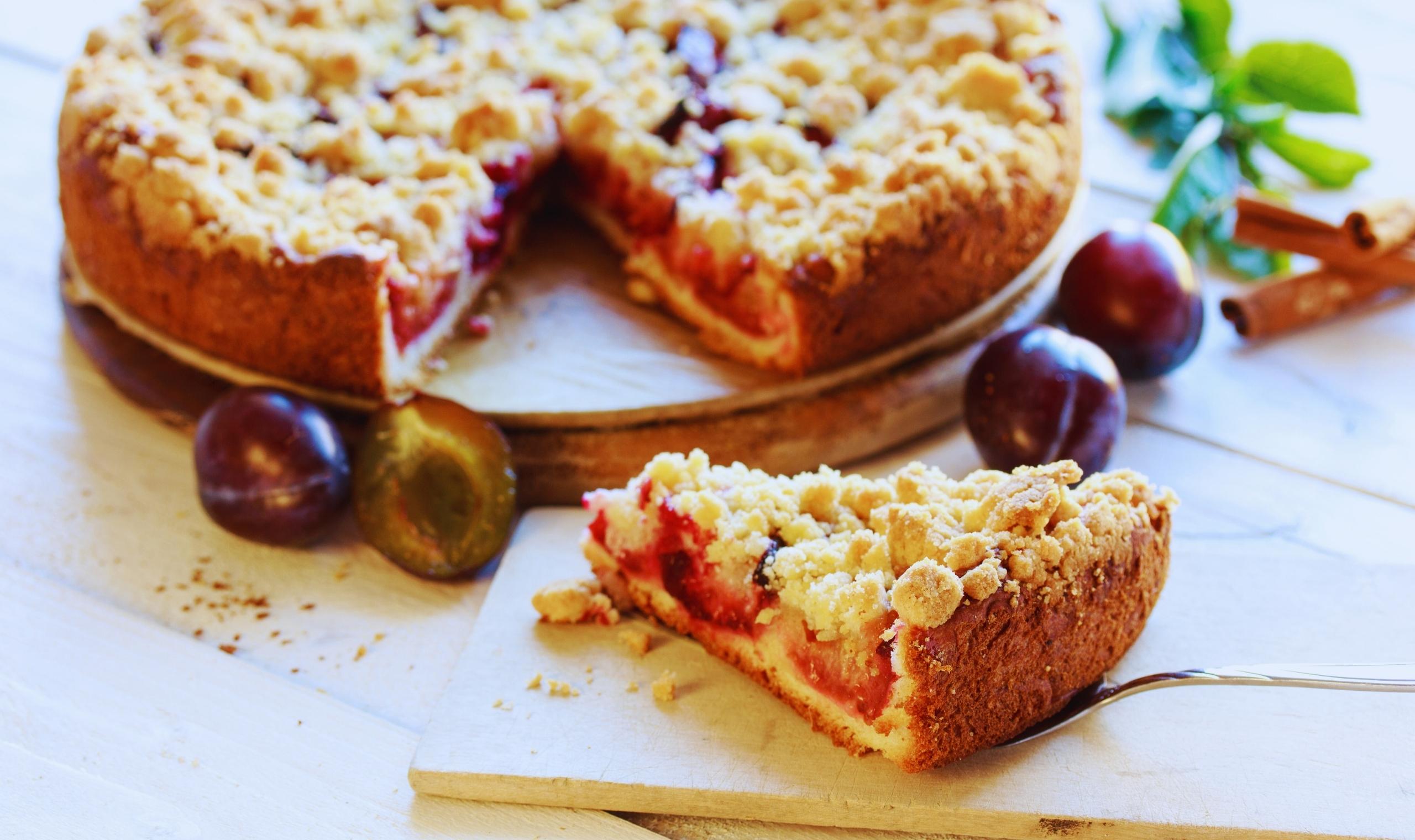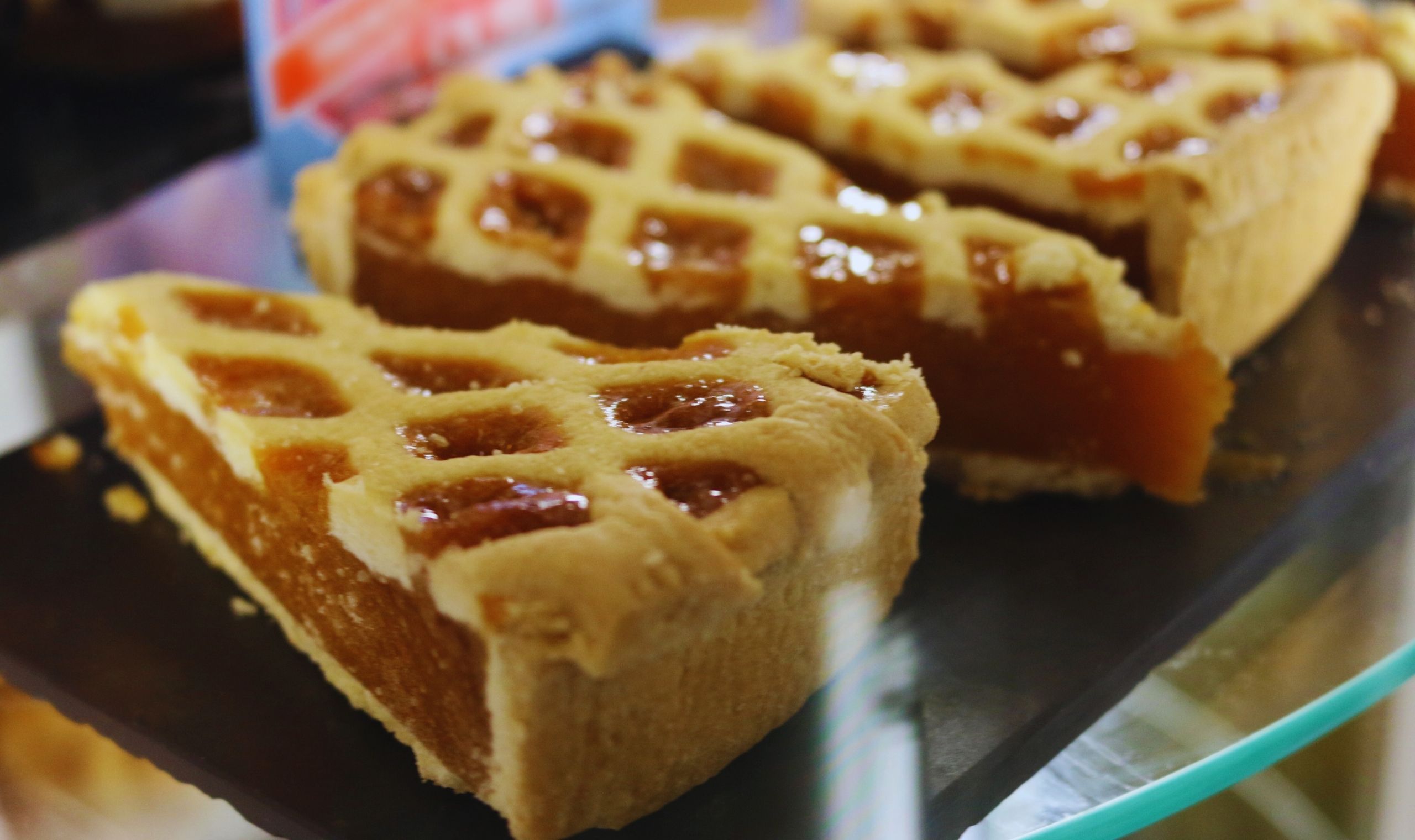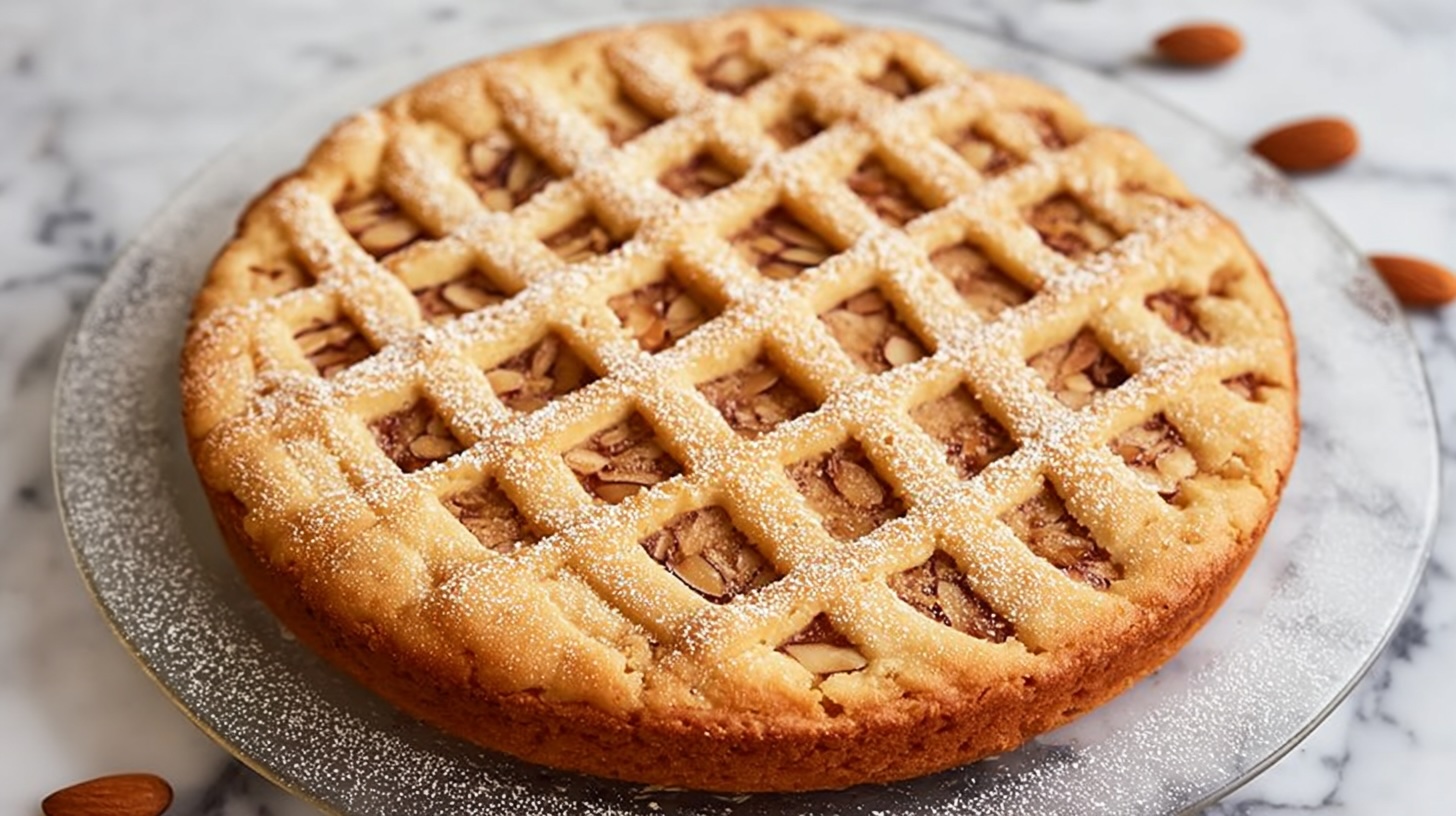Pflaumenkuchen (German Plum Pie)
German Plum Pie or Pflaumenkuchen
Pflaumenkuchen, often referred to as plum pie, is a beloved dessert in Germany that showcases the rich flavors of fresh plums. This traditional treat is deeply rooted in German culinary culture, reflecting the country’s agricultural practices and seasonal festivities. Typically enjoyed during the late summer and early autumn months, Pflaumenkuchen symbolizes the harvest season, when plums are at their peak ripeness.
The origins of Pflaumenkuchen can be traced back to regional recipes developed in Germany, where plums have been cultivated for centuries. Different regions may have their own variations, incorporating unique ingredients or baking techniques that reflect local customs. This diversity not only enhances the flavors of the dessert but also fosters a sense of community as families gather to enjoy this sweet delight together. The significance of Pflaumenkuchen extends beyond mere taste; it often plays a central role in family gatherings, celebrations, and festive occasions.
In many German homes, pflaumenkuchen is a cherished recipe passed down through generations, bringing families together and embodying the love of baking. Its popularity is a testament to its status as not just a dessert, but a cultural icon that celebrates the flavors of the season and the experience of sharing food with loved ones.
Ingredients Needed for Pflaumenkuchen
To prepare a delectable pflaumenkuchen, or plum pie as it is often referred to in English, one must gather a selection of fresh ingredients that will enhance the overall flavor and texture of this German dessert. The key components necessary for the buttery crust and the flavorful filling include the following:
Firstly, for the buttery crust, the primary ingredients are all-purpose flour, unsalted butter, granulated sugar, and eggs. Using high-quality unsalted butter is essential, as it contributes to the rich and delicate flavor profile. Typically, about 250 grams of flour will require approximately 125 grams of butter, 75 grams of sugar, and one egg to create a smooth dough that can be rolled out easily. It is advisable to chill the butter before use, which helps in achieving a flaky texture.
Next, the filling is where the star ingredient, fresh plums, takes center stage. For the best results, it is recommended to use ripe, seasonal plums such as Fischer plums or Italian plums, known for their sweetness and juiciness. The quantity needed is usually about 500 grams, pitted and halved. Additionally, cinnamon and nutmeg can be optionally included as spices to enhance the sweetness of the plums, allowing for a warmer flavor profile.
Finally, some recipes suggest incorporating a small amount of vanilla extract or a sprinkle of powdered sugar after baking for an elevated taste experience. It is crucial to emphasize the importance of using fresh and seasonal ingredients, as they provide not only the best flavor but also a vibrant appearance, making the pflaumenkuchen an appealing dessert worthy of any occasion.
The Perfect Buttery Crust
Creating the ideal buttery crust for pflaumenkuchen, or plum pie, is an essential step in achieving a delectable dessert that showcases the natural sweetness of fresh plums. The crust serves as the foundation of the pie, and its texture can significantly impact the overall flavor profile. To make a perfect crust, start by selecting high-quality ingredients, including unsalted butter, all-purpose flour, sugar, salt, and cold water. The use of cold ingredients ensures that the butter remains firm during the mixing process, contributing to a flaky texture.
The first step in the process involves cutting the cold butter into small cubes and combining it with flour, sugar, and salt in a mixing bowl. To achieve the desired consistency, use a pastry cutter or your fingers to mix until the mixture resembles coarse crumbs. It is essential to avoid overworking the dough at this stage, as this can lead to a denser texture rather than the light and airy pie crust that is characteristic of pflaumenkuchen.
Once the mixture is combined, gradually add cold water, one tablespoon at a time, mixing gently until the dough starts to come together. At this point, it is advisable to form the dough into a disc, wrap it in plastic wrap, and refrigerate for at least 30 minutes. This resting time is crucial, as it allows the gluten to relax, making the dough easier to roll out while promoting a tender texture.
For those looking to enhance the flavor of the buttery crust, consider adding a pinch of almond extract or lemon zest during the mixing process. These small additions can elevate the taste, complementing the sweet and tart notes of the plums. With the right technique and flavorful variations, the crust of your pflaumenkuchen will not only provide a supportive base but also add a delightful taste to the overall pie experience.
Preparing the Plums
To create a delicious pflaumenkuchen, the preparation of the plums plays a crucial role in ensuring the flavor and texture of the plum pie are optimal. Start by selecting fresh, high-quality plums, which are essential for a balanced and flavorful filling. Varieties such as Italian plums, Damson plums, or Stanley plums are excellent choices, as they offer a delightful sweetness combined with a hint of tartness. Aim for plums that are slightly firm to the touch yet yield under gentle pressure, indicating ripeness.
Once you have chosen your plums, it’s time to wash them thoroughly under cold running water. This step is important to remove any dirt or residues that may be present on the skin. After washing, pat the plums dry with a clean towel. Next, you will need to pit the plums. Using a sharp paring knife, slice the plum in half along its natural seam, then carefully twist to separate the halves and remove the pit. If you’re using a variety with clingstone pits, you may need to cut more deeply to release the fruit. Discard the pits and any damaged or overripe pieces that may affect the overall quality of your plum pie.
After pitting, slice the plums into wedges or smaller pieces, depending on your desired texture for the filling. The general rule is to aim for uniform slices to ensure even cooking. To enhance the natural sweetness of the plums, consider tossing them in a modest amount of sugar. A blend of sugar, along with a pinch of lemon juice, can help balance the tartness and elevate the flavor profile of the pflaumenkuchen. This process of preparing the plums is not only vital for taste but also contributes significantly to the overall success of your plum pie.
Building the Pie: Layering and Assembly
Creating the perfect pflaumenkuchen involves a careful process of layering and assembly that not only enhances the pie’s flavor but also its visual appeal. Once you have prepared your buttery crust and fresh plums, the next step is to layer the plums evenly over the base. Begin by arranging the halved plums cut-side up onto the crust. This arrangement not only creates an attractive presentation but also ensures that the plums caramelize beautifully during baking.
As you place the plums, consider the natural gradient of color – the vibrant purples and yellows will create an inviting look. Aim for a uniform distribution of fruit to achieve even cooking throughout the pflaumenkuchen. This technique provides not only aesthetic appeal but also ensures that each slice delivers a balanced taste of tartness and sweetness derived from the plums.
To elevate your plum pie further, you can incorporate a sprinkle of spices such as cinnamon or nutmeg, which complement the plum’s flavor profile remarkably. Adding these spices to the tops of your plums before proceeding to the next layer can enhance the depth of flavor. Another excellent option is to prepare a crumble topping made from flour, sugar, and butter. The crumble will add a delightful crunch that contrasts beautifully with the softness of the baked plums.
Layering doesn’t stop at just plums; consider adding thin slices of almonds or a dusting of powdered sugar as finishing touches. These not only add texture but also contribute to a richer overall taste. After arranging everything meticulously, ensure that the pie is aligned with your culinary vision, and then it is ready for baking. The meticulous layering of ingredients in your pflaumenkuchen can set the stage for a mouthwatering dessert that everyone will enjoy.
Baking the Pflaumenkuchen
Baking a perfect pflaumenkuchen requires attention to detail, ensuring that the buttery crust complements the juicy plums beautifully. To begin the process, preheat your oven to a temperature of 180°C (350°F). This temperature is ideal for allowing the crust to crisp up while ensuring the fruits cook evenly. Once the oven reaches the desired temperature, place the prepared plum pie in the center for optimal heat distribution.
The baking time for pflaumenkuchen typically ranges from 40 to 50 minutes. To monitor your pie’s progress, keep an eye on the crust’s color; it should turn golden brown. Additionally, you can check the plums. They should become tender and bubbly, releasing their natural juices without overflowing excessively. A toothpick inserted in the crust should come out clean when the pflaumenkuchen is fully baked. These signs indicate that your plum pie is ready to be taken out of the oven.
Preventing a soggy bottom crust is crucial for the overall texture of the pflaumenkuchen. To avoid this common issue, consider pre-baking the crust for about 10 minutes before adding the plums. This initial baking will help create a barrier, preserving the integrity of the crust against the moist filling. Additionally, using a mix of flour and cornstarch with the plums can help absorb excess juices, further guarding against sogginess.
Once your pflaumenkuchen is out of the oven, allow it to cool for at least 15 to 20 minutes before serving. This cooling period helps the filling set and makes cutting the pie easier. A warm slice of plum pie accompanied by a dollop of whipped cream or a scoop of vanilla ice cream is a delicious treat, but patience will enhance the overall eating experience.
Serving Suggestions for Pflaumenkuchen
Pflaumenkuchen, a quintessential German plum pie, offers a delightful taste experience that can be further enhanced through thoughtful serving suggestions. To complement the rich, buttery flavor of the pastry and the natural sweetness of the fresh plums, a dollop of whipped cream can be an excellent choice. The lightness and creaminess of whipped cream provide a contrast to the textured pie, making each bite more enjoyable. For a warmer option, consider serving a slice alongside a scoop of vanilla ice cream; the melty ice cream against the warm pie creates a heavenly combination, elevating your dessert to a new level.
Another appealing accompaniment is crème fraîche, which offers a tangy richness that pairs beautifully with the sweet and slightly tart flavor of the plums. This creamy topping adds a sophisticated note to the pflaumenkuchen, making it suitable for more formal occasions as well. Should you wish to introduce a hint of spice, a sprinkle of cinnamon or nutmeg on top can enhance the flavor profile, giving a warm and inviting aroma that is especially enticing during colder months.
The versatility of pflaumenkuchen allows for its enjoyment on various occasions. It makes for an appealing dessert choice during family dinners, providing an opportunity for everyone to gather and savor a slice together. Additionally, this plum pie shines at festive gatherings such as birthdays or holiday celebrations, where its vibrant color and rich flavor serve as an attractive centerpiece. Furthermore, the cake can also be a delightful offering during coffee breaks, allowing friends and family to indulge in a comforting treat that encourages relaxation and conversation.
Variations of Pflaumenkuchen
Pflaumenkuchen, commonly known as plum pie, is a versatile dessert that can be adapted to cater to various dietary preferences and seasonal ingredients. While the classic version is delicious, many variations exist that incorporate alternative ingredients, making it suitable for a broader range of tastes. A popular adaptation is the gluten-free pflaumenkuchen. This variant typically substitutes traditional flour with alternatives such as almond flour, coconut flour, or a gluten-free flour blend. These options maintain the delightful flavor and texture while offering a satisfying experience for individuals with gluten sensitivities.
In addition to the gluten-free option, the recipe for pflaumenkuchen can be enhanced using different fruits to suit personal preferences or what is available seasonally. While plums take center stage in the traditional recipe, fruit such as peaches, cherries, or apples can also be utilized to create a delicious twist. Each fruit brings its unique flavor profile, allowing for creativity and seasonal adaptation. For example, a peach and plum combination can be especially delightful during the summer months.
Furthermore, creative toppings and flavor enhancements can elevate the classic pflaumenkuchen experience. Adding a streusel topping made from oats, nuts, or spices such as cinnamon can provide an added crunch and flavor depth. Alternatively, incorporating a layer of cream cheese or ricotta cheese on the crust can introduce creaminess, complementing the sweetness of the fruit. Some bakers may even experiment with zest from citrus fruits or a drizzle of honey to personalize their creation further. By exploring these variations, enthusiasts can enhance their experience of pflaumenkuchen while catering to specific dietary needs and enjoying a broader range of flavors.
The Joy of Baking Pflaumenkuchen
Baking pflaumenkuchen, or plum pie, offers a delightful experience that extends beyond merely following a recipe. The process of preparing this buttery dessert is an opportunity to engage with the ingredients and embrace the aromas that fill the kitchen as it cooks. As fresh plums are sliced and arranged on a base of delicately crafted dough, one becomes part of a tradition that is cherished by many. The tactile nature of baking encourages mindfulness and creativity, allowing one to express personal touches through variations in spices or added ingredients.
Moreover, pflaumenkuchen serves not only as a culinary treat but also as a catalyst for creating memorable moments with family and friends. Sharing a freshly baked plum pie can ignite conversations, bringing people together to savor not only the pie but also the companionship that accompanies it. Each bite evokes nostalgia and signifies the joy of home-cooked meals, which are integral to many cultures around the world. The act of baking this pie can be a family affair, fostering collaboration and teamwork in the kitchen.
For those who might be hesitant, I encourage you to embark on this baking journey. Whether you seek to perfect the classic recipe or experiment with your spin on pflaumenkuchen, you will undoubtedly find satisfaction in the process. Additionally, don’t forget to take note of your experiences; every trial can lead to improvement and new discoveries. Sharing your creations with others can lead to lasting memories, making the endeavor of baking as rewarding as the delicious end product itself. The joy of creating your own pflaumenkuchen is an experience worth savoring, one that promises to please both the palate and the heart.



